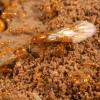- Formiculture.com
- Forums
- Gallery
- Members
- Member Map
- Chat

237 replies to this topic
#101
 Offline
-
Posted December 2 2014 - 2:41 PM
Offline
-
Posted December 2 2014 - 2:41 PM
I had some grout in the formicariums.
Remember Dragon Warrior, anything is possible when you have inner peace. - Master Shifu
Current Queens:
1 Unknown Pogomyemex
1 Solenopsis Xyloni
Current Queens:
1 Unknown Pogomyemex
1 Solenopsis Xyloni
#102
 Offline
-
Posted December 3 2014 - 4:42 PM
Offline
-
Posted December 3 2014 - 4:42 PM
Will they chew through the silicone too? Also, what about making connection ports to join containers?
#103
 Offline
-
Posted December 3 2014 - 4:48 PM
Offline
-
Posted December 3 2014 - 4:48 PM
Will they chew through the silicone too? Also, what about making connection ports to join containers?
Many ants will tunnel through silicone rubber. They just have to get a good grip on it.
The smoother the application, the less places where they can sink their mandibles into it to gnaw off a chunk.
byFormica® is the manufacturer of the iconic nectar feeders and Sunburst Ant Nectar.
byFormica ant products always deliver consistent performance, convenience,
and reliability, making them among the most beloved ant foods and kit enjoyed by
ant keeping enthusiasts worldwide. For more information, visit www.byFormica.com.
#104
 Offline
-
Posted December 5 2014 - 11:58 PM
Offline
-
Posted December 5 2014 - 11:58 PM
Drew, the ants tunneling in the ytong may be a problem with the material. I had a block that I recently carved where one end was hard like it should be and the other was almost as soft as chalk. This made carving a breeze 😀
#105
 Offline
-
Posted December 6 2014 - 12:33 AM
Offline
-
Posted December 6 2014 - 12:33 AM
Yeah, it's very inconsistent stuff on a small scale. It's okay though, I would rather have something more consistent and stronger anyways.
#106
 Offline
-
Posted December 30 2014 - 5:49 PM
Offline
-
Posted December 30 2014 - 5:49 PM
I finally took the prototype that the Veromessor chewed through apart and removed the Ytong. You can see how much of it the ants chewed away.
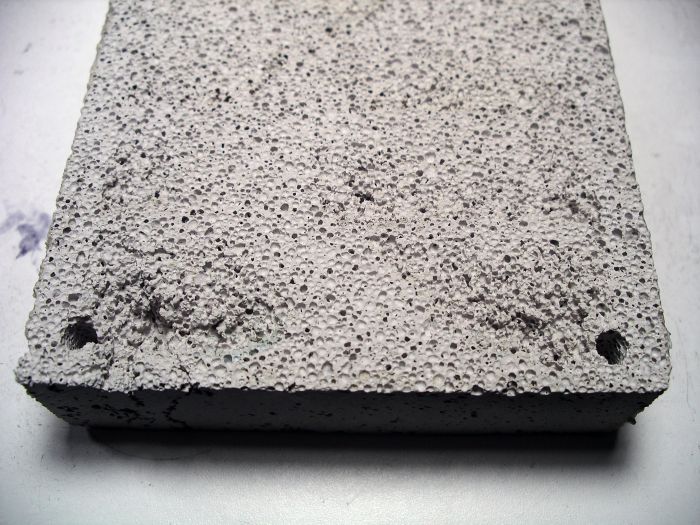
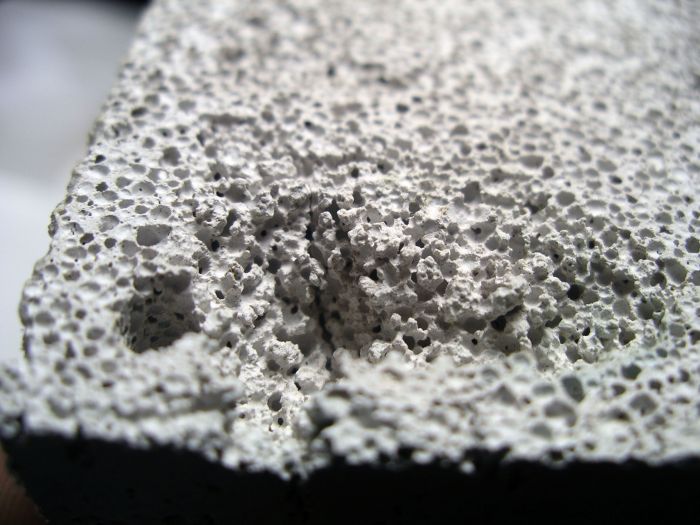
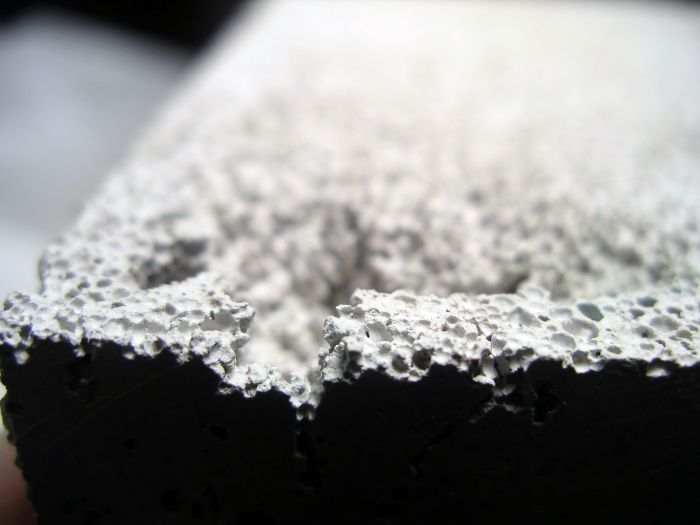
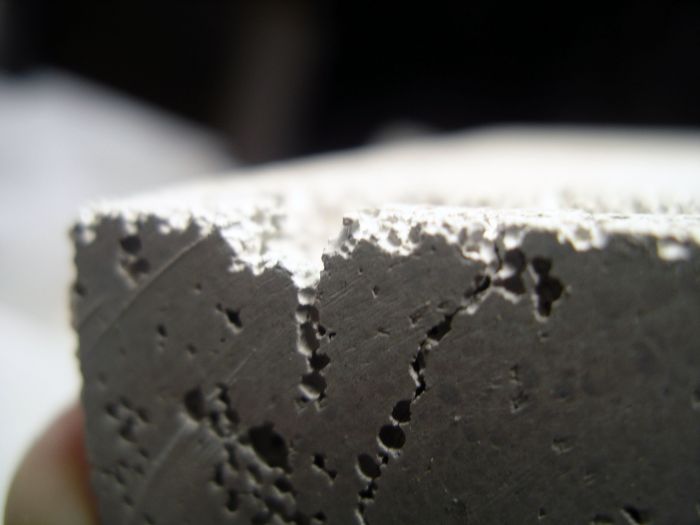
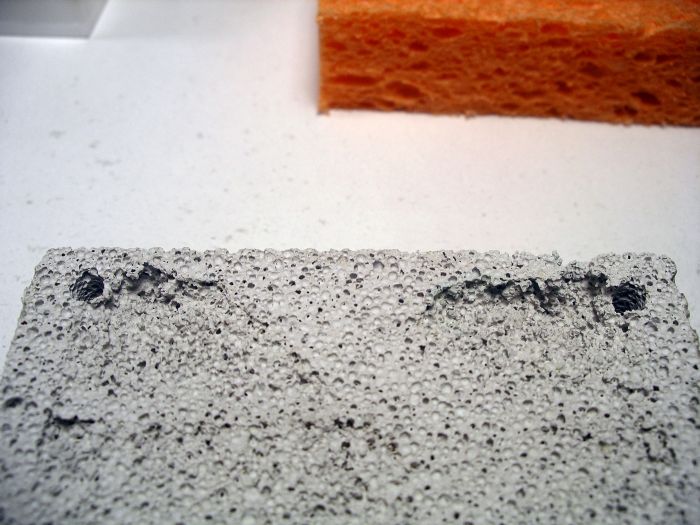
I glued some 100 micron nylon mesh with 32% open area to the back of one of the plates.
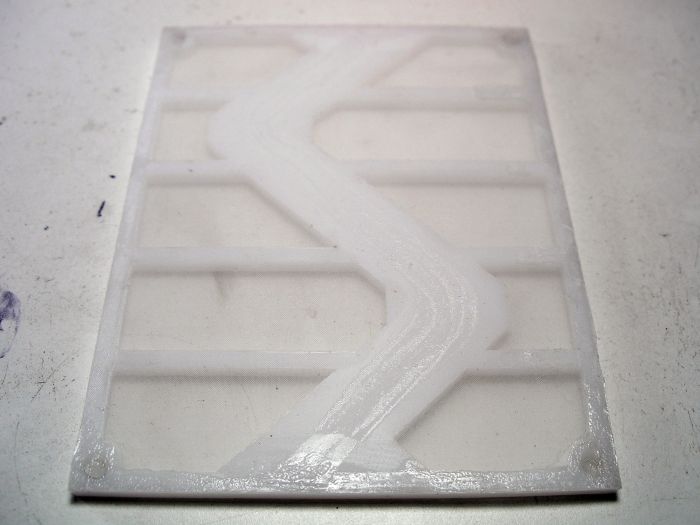
I quickly rigged up a back plate that will be used to press the sponge tightly up against the nest.
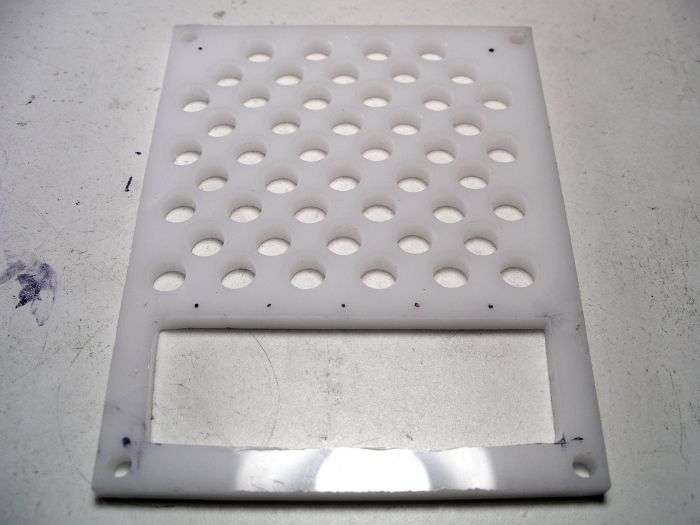
Here is the PVA sponge I'll be using next to a regular common sponge. These sponges are very dense, and hold way more water.
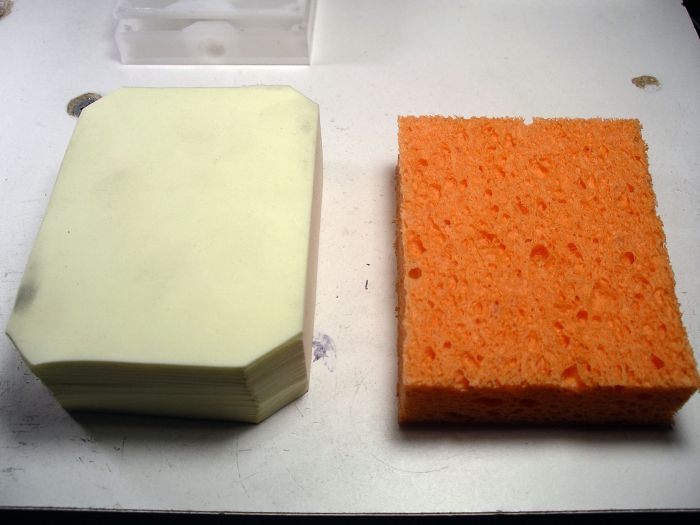
Here it is all put together.
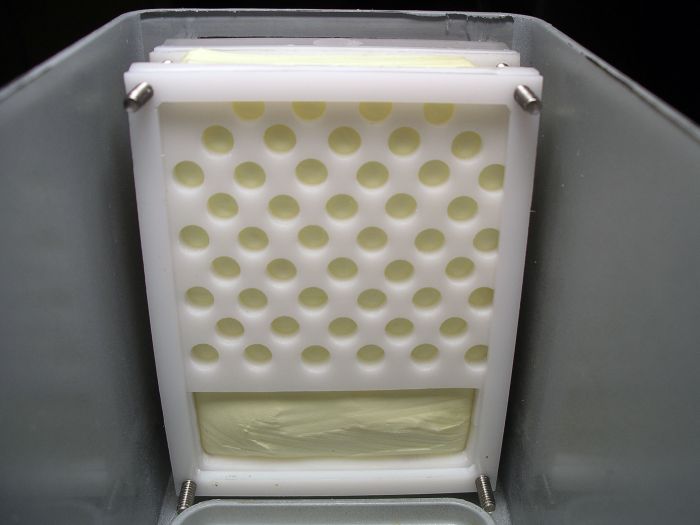
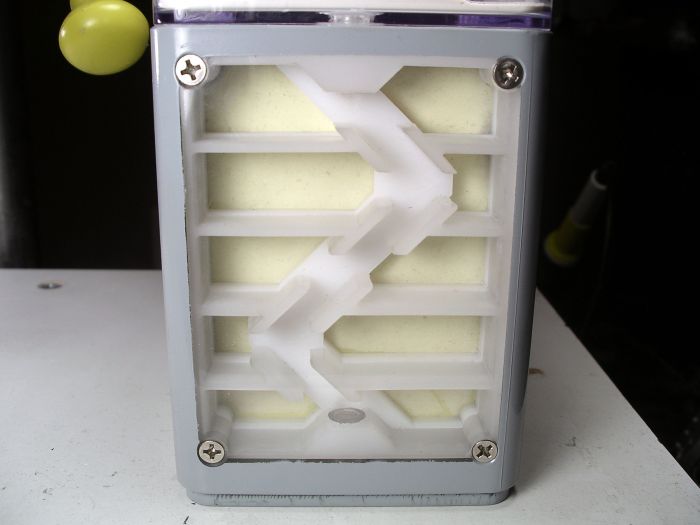
I already moved the ants back into the nest, and they quickly made it their home. The new backing is soaking up the water perfectly and keeping the bottom chambers very humid.
One very strange thing I noticed, is they don't seem to like the nylon mesh/sponge backing. They seem happy with the nest, but hardly any of them stand on or even get near the back wall now. Instead of the back of the chambers, they stand all over the front of the chambers, making it harder to view them. They even pile all of their brood toward the front, keeping it away from the backing. I have no idea what would be causing this. I dropped a piece of a PVA sponge and common sponge in the out world, and they all crowded around both, drinking the water that was soaking into the Hydrostone, but didn't do much climbing onto the sponges. I also tried sticking a piece of the nylon mesh in there, and they didn't seem to mind it at all. I'll have to keep testing things out until I can figure out exactly what's causing this.
At the time I removed the water tank about two weeks ago, it was about half empty. Since it was in there for about one month, this would mean that this tank, being smaller than the original, will probably last about two months, which sounds about right.





I glued some 100 micron nylon mesh with 32% open area to the back of one of the plates.

I quickly rigged up a back plate that will be used to press the sponge tightly up against the nest.

Here is the PVA sponge I'll be using next to a regular common sponge. These sponges are very dense, and hold way more water.

Here it is all put together.


I already moved the ants back into the nest, and they quickly made it their home. The new backing is soaking up the water perfectly and keeping the bottom chambers very humid.
One very strange thing I noticed, is they don't seem to like the nylon mesh/sponge backing. They seem happy with the nest, but hardly any of them stand on or even get near the back wall now. Instead of the back of the chambers, they stand all over the front of the chambers, making it harder to view them. They even pile all of their brood toward the front, keeping it away from the backing. I have no idea what would be causing this. I dropped a piece of a PVA sponge and common sponge in the out world, and they all crowded around both, drinking the water that was soaking into the Hydrostone, but didn't do much climbing onto the sponges. I also tried sticking a piece of the nylon mesh in there, and they didn't seem to mind it at all. I'll have to keep testing things out until I can figure out exactly what's causing this.
At the time I removed the water tank about two weeks ago, it was about half empty. Since it was in there for about one month, this would mean that this tank, being smaller than the original, will probably last about two months, which sounds about right.
- nepenthes and drtrmiller like this
#107
 Offline
-
Posted December 30 2014 - 6:05 PM
Offline
-
Posted December 30 2014 - 6:05 PM
Fantastic breakdown of the assembly, as always.
- dspdrew likes this
byFormica® is the manufacturer of the iconic nectar feeders and Sunburst Ant Nectar.
byFormica ant products always deliver consistent performance, convenience,
and reliability, making them among the most beloved ant foods and kit enjoyed by
ant keeping enthusiasts worldwide. For more information, visit www.byFormica.com.
#108
 Offline
-
Posted December 30 2014 - 7:32 PM
Offline
-
Posted December 30 2014 - 7:32 PM
Why not make a sheet of hydrostone and use that in the place of the ytong? I imagine it would be stronger and less prone to being dug through.
#109
 Offline
-
Posted December 30 2014 - 7:48 PM
Offline
-
Posted December 30 2014 - 7:48 PM
Why not make a sheet of hydrostone and use that in the place of the ytong? I imagine it would be stronger and less prone to being dug through.
We've recently discovered that plaster, including gypsum-based stones, deteriorate over time when water passes through them, continuously. Somewhere, Drew posted pictures showing how the water eats away at the hydrostone.
Put a piece of plaster in some lemon juice, and it will fizz until little or nothing is left. Plain water appears to exhibit the same effect, but over a much longer time scale.
byFormica® is the manufacturer of the iconic nectar feeders and Sunburst Ant Nectar.
byFormica ant products always deliver consistent performance, convenience,
and reliability, making them among the most beloved ant foods and kit enjoyed by
ant keeping enthusiasts worldwide. For more information, visit www.byFormica.com.
#110
 Offline
-
Posted December 30 2014 - 7:57 PM
Offline
-
Posted December 30 2014 - 7:57 PM
Maybe try using R/O water and balance the PH? Maybe if its more alkaline or acidic you can adjust to just a little over neutral or under. IE - if it measures 8.0 pH make it 6.8 pH. This sounds like a chemical reaction between the gypsum and water. However, the gypsum could be being oxidozed by the water regardless. I wonder if there is a simple method that's safe for the ants, protects the integrity of the building material, as well as hopefully aid as a microbial inhibitor.
#111
 Offline
-
Posted December 30 2014 - 8:42 PM
Offline
-
Posted December 30 2014 - 8:42 PM
Maybe try using R/O water and balance the PH? Maybe if its more alkaline or acidic you can adjust to just a little over neutral or under. IE - if it measures 8.0 pH make it 6.8 pH. This sounds like a chemical reaction between the gypsum and water. However, the gypsum could be being oxidozed by the water regardless. I wonder if there is a simple method that's safe for the ants, protects the integrity of the building material, as well as hopefully aid as a microbial inhibitor.
Yeah, I recommended reducing the PH to Drew. He thought simply adding a layer of hydrostone to the reservoir containing the water may have the effect of mineralizing the water and bringing the PH to homeostasis with that of the hydrostone, above, through which the water would be passing.
We'll see.
byFormica® is the manufacturer of the iconic nectar feeders and Sunburst Ant Nectar.
byFormica ant products always deliver consistent performance, convenience,
and reliability, making them among the most beloved ant foods and kit enjoyed by
ant keeping enthusiasts worldwide. For more information, visit www.byFormica.com.
#112
 Offline
-
Posted December 30 2014 - 8:46 PM
Offline
-
Posted December 30 2014 - 8:46 PM
Maybe, if it really is a chemical reaction then it might help. But isn't hydrostone a gypsum based material? It could be an erosion effect from the evaporation and movement of water. How long were the nests used before the erosion issue occurred?
#113
 Offline
-
Posted December 31 2014 - 1:12 AM
Offline
-
Posted December 31 2014 - 1:12 AM
Well, if we are talking specifically about the latest nests to have this problem--the fungus-grower nests, this happened in about eight hours when I put substrate in one of them as a test for a cricket breeding bin idea I had. You can see what I'm talking about here (https://www.formicul...26-2014/?p=9594). It created a pin hole all the way through a 1/4 inch of Hydrostone. This was of course passing quite a bit of water though it all day long, whereas the fungus-grower nests pass a very small amount of water each day, so it would probably take a long time for a hole to form in one being used that way.
This issue is much more of a problem for my Formicarium #8, which you can see here (https://www.formicul....php/topic/784-), so I'll be discussing it in much more detail on that thread.
This issue is much more of a problem for my Formicarium #8, which you can see here (https://www.formicul....php/topic/784-), so I'll be discussing it in much more detail on that thread.
#114
 Offline
-
Posted January 7 2015 - 11:56 AM
Offline
-
Posted January 7 2015 - 11:56 AM
A couple minor problems.
I took apart the third prototype (the one I had the Camponotus in) to made some updates to the design. I noticed there was a little bit of fuzzzy white mold growing on the side of the very bottom part of the Ytong. This was probably because of some fluids that soaked into it from inside the nest. It wasn't enough to really be worried about.
The back 3/4 inch Ytong plate was cracked in half from the pressure of the screws, so a thicker/stronger back brace/frame would have probably kept that from happening.
The sponge fell off the water tank. I need to find a better way to attach the sponge to the tank.
I'm probably not even going to be using Ytong for these anymore, so some of these problems don't matter for now.
As for the water level, it was about half way, which means this one would have lasted for a little over two months, which is right around what I predicted.
#115
 Offline
-
Posted January 9 2015 - 6:40 AM
Offline
-
Posted January 9 2015 - 6:40 AM
Ever since I redesigned the second prototype to use a sponge instead, it has been leaking pretty bad. I'm not sure why, because it really shouldn't behave any different than the Ytong block in that regard. I suspect it has something to do with the plastic frame/brace in the back. I lifted the tank up slightly where it connects to the sponge backing, so it's not touching the bottom part of the brace to see if I'm correct. I also setup a sponge and a tank on the counter to watch and see if it leaks for some strange reason.
It looks like the ants have started walking and standing on the sponge backing now, so that might not be so much of a problem after all. They do have their brood away from it still, but I think that's because of how damp it is. Because these sponges soak up water so well, the entire sponge is wet, not leaving much of a moisture gradient on something this small, and that might be a problem.
#116
 Offline
-
Posted January 9 2015 - 9:47 AM
Offline
-
Posted January 9 2015 - 9:47 AM
I've decided there is no such thing as a "moisture gradient," in terms of humidity in the air. If the nest is well-designed, which means it is well-ventilated, then it will all be about the same relative humidity.
With the setup you have, however, many ants will likely choose to keep eggs and larvae closer to the wet sponge, and pupae further away from anything wet. This seems like an ideal setup—the whole formicarium isn't soaking wet, but there is both wet and dry space.
byFormica® is the manufacturer of the iconic nectar feeders and Sunburst Ant Nectar.
byFormica ant products always deliver consistent performance, convenience,
and reliability, making them among the most beloved ant foods and kit enjoyed by
ant keeping enthusiasts worldwide. For more information, visit www.byFormica.com.
#117
 Offline
-
Posted January 9 2015 - 12:06 PM
Offline
-
Posted January 9 2015 - 12:06 PM
Yeah, when I talk about a moisture gradient, I'm not talking about the humidity, I'm talking about the moisture in the walls of the nest.
#118
 Offline
-
Posted January 13 2015 - 9:29 PM
Offline
-
Posted January 13 2015 - 9:29 PM
I finally put the 3rd prototype back together using a synthetic chamois and nylon mesh for the backing this time.
I used a stronger, thicker piece of acrylic for the back brace this time.
By the way, the strange pattern you see on some of my pieces of acrylic is there because they actually came out of LCD monitors. These monitors have a 3/8 inch or sometimes a 1/4 inch thick piece of acrylic in them the size of the screen. if you don't mind a little frosted dot pattern, you can get yourself a piece of acrylic that would cost you quite a bit otherwise.
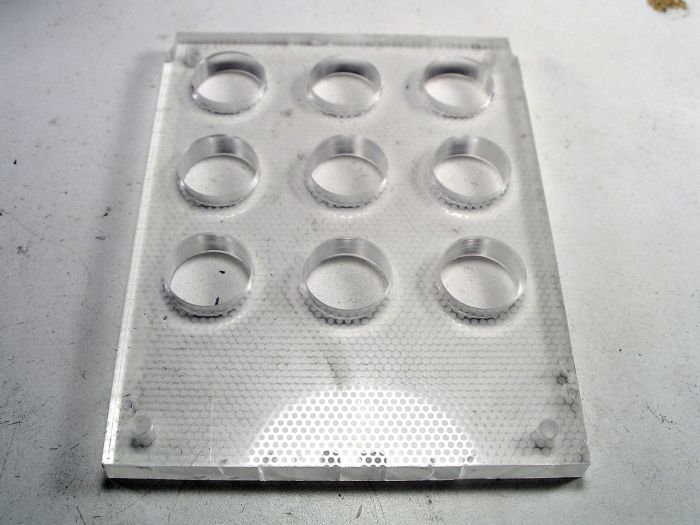
This here is the synthetic chamois. I'm pretty sure it's made from PVA. Instead of leaving an open area for the water tank's sponge to get to the absorbent backing, I just decided to wrap it around the bottom and up the back side. This material is so absorbent, it seems like there is no end to the distance the water will travel through it.
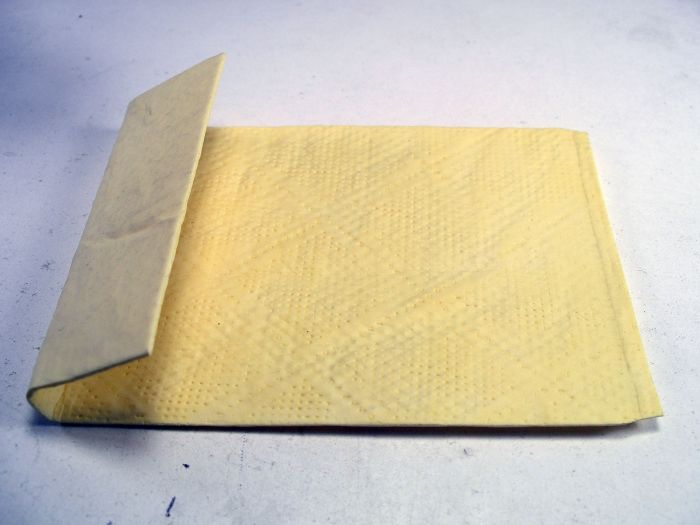
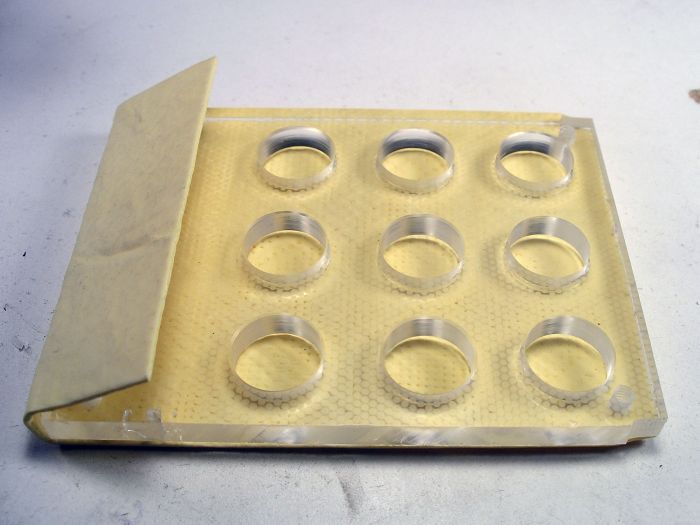
Mounted with the old back brace on as well, for nothing more than to hold up the chamois in the back.
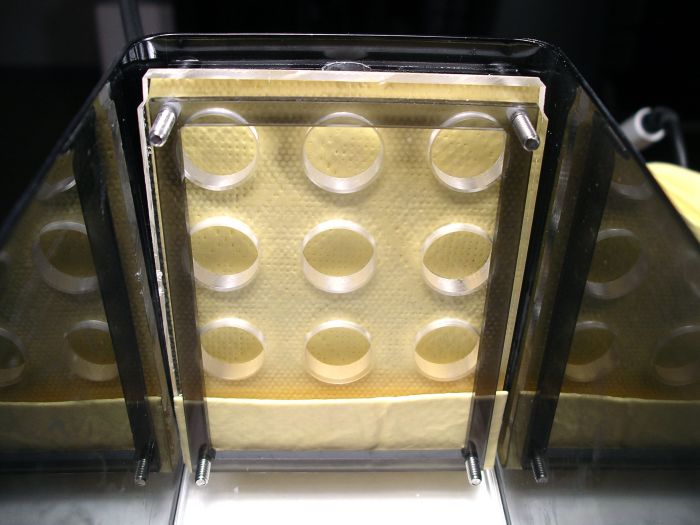
Water tank installed and sponge making contact with backing.
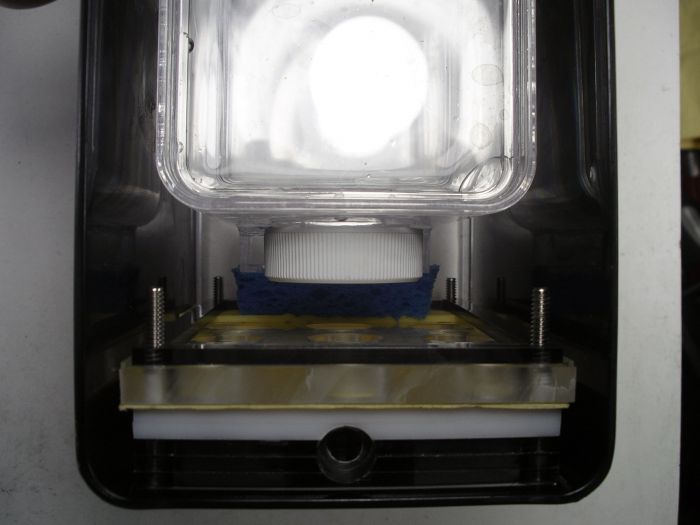
Again, funky colors, but good enough for testing.
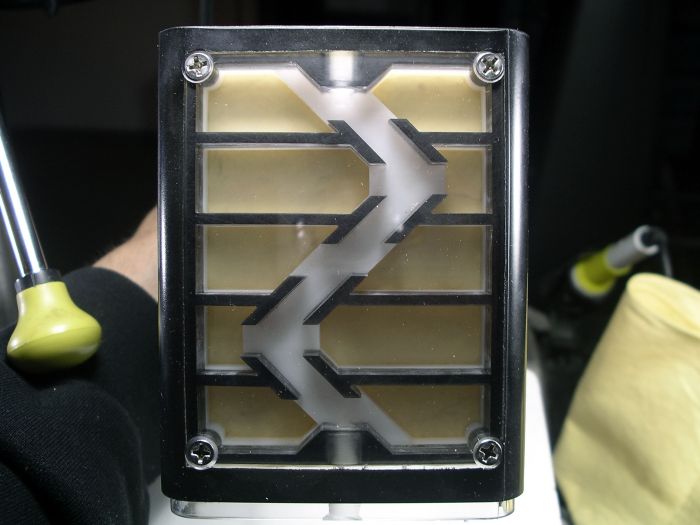
I finally tore apart the first prototype that the Pogonomyrmex subnitidus colony chewed through. Yeah, it was quite a mess.
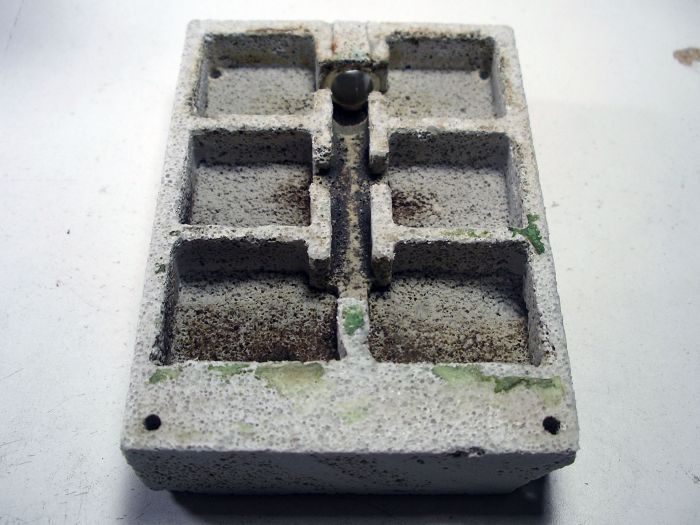
You can see the hole here where they were traveling between the nest and the inside of the base container.
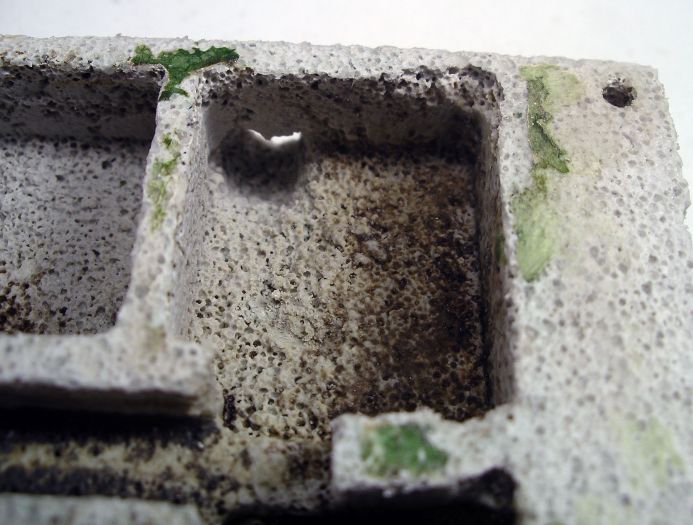
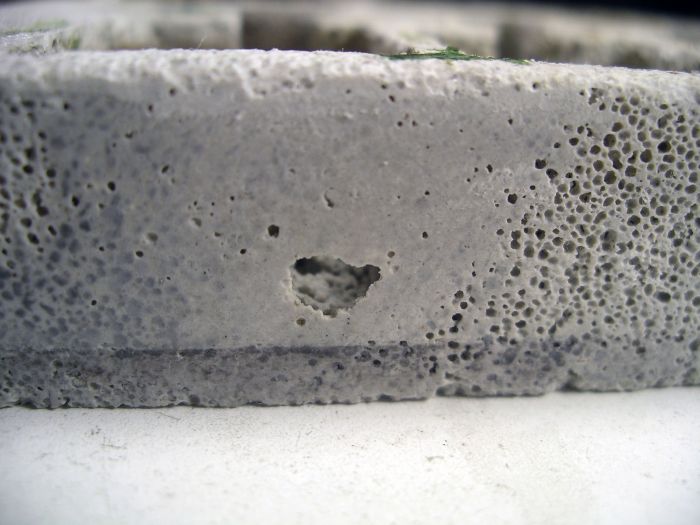
Here you can see the same erosion problem I've been having with cement based materials due to the pH of the water. That line of erosion is where the holes in the water tank made contact.
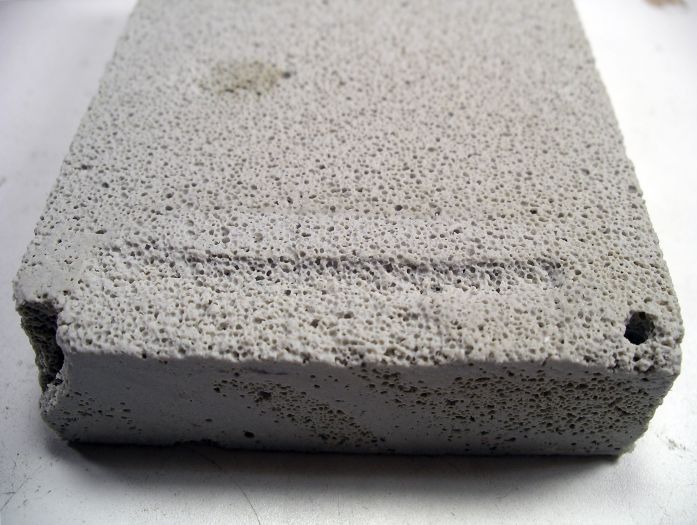
By the way, this larger water tank that lasted about three months the first time was only about 3/4 the way empty, and only a week away from the four month mark, so most likely it would have lasted about five months this time.
I used a stronger, thicker piece of acrylic for the back brace this time.
By the way, the strange pattern you see on some of my pieces of acrylic is there because they actually came out of LCD monitors. These monitors have a 3/8 inch or sometimes a 1/4 inch thick piece of acrylic in them the size of the screen. if you don't mind a little frosted dot pattern, you can get yourself a piece of acrylic that would cost you quite a bit otherwise.

This here is the synthetic chamois. I'm pretty sure it's made from PVA. Instead of leaving an open area for the water tank's sponge to get to the absorbent backing, I just decided to wrap it around the bottom and up the back side. This material is so absorbent, it seems like there is no end to the distance the water will travel through it.


Mounted with the old back brace on as well, for nothing more than to hold up the chamois in the back.

Water tank installed and sponge making contact with backing.

Again, funky colors, but good enough for testing.

I finally tore apart the first prototype that the Pogonomyrmex subnitidus colony chewed through. Yeah, it was quite a mess.

You can see the hole here where they were traveling between the nest and the inside of the base container.


Here you can see the same erosion problem I've been having with cement based materials due to the pH of the water. That line of erosion is where the holes in the water tank made contact.

By the way, this larger water tank that lasted about three months the first time was only about 3/4 the way empty, and only a week away from the four month mark, so most likely it would have lasted about five months this time.
#119
 Offline
-
Posted January 15 2015 - 8:43 PM
Offline
-
Posted January 15 2015 - 8:43 PM
I think I might just make these nests out of Hydrostone completely now that I have solved the erosion problem. Hydrostone nests would be very easy and cheap to make, and much more natural and better for the ants. The only problem is it absorbs water so well, that for a nest this size, there wouldn't be much of any moisture gradient. I am also hoping that Hydrostone will be hard enough to keep Pogonomyrmex and Veromessor from chewing through it. considering there aren't any large pores for them to get their mandibles into, the probably wouldn't be able to do much damage.
To give it a try, I carved a simple nest out of a Hydrostone block to use with the first prototype that I removed the chewed up Ytong nest from.
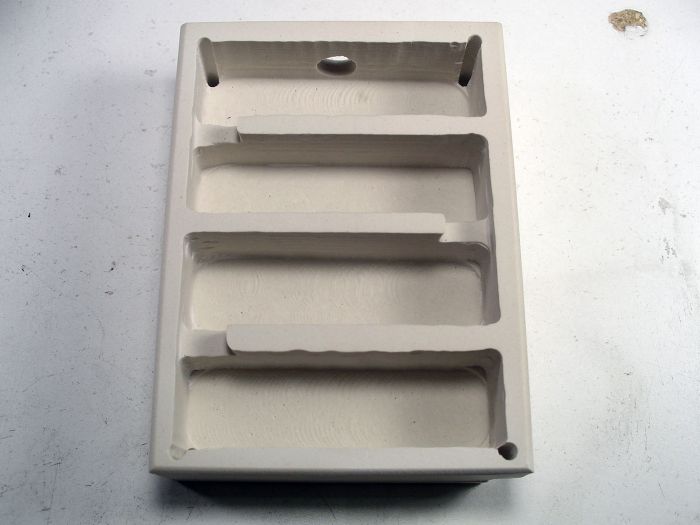
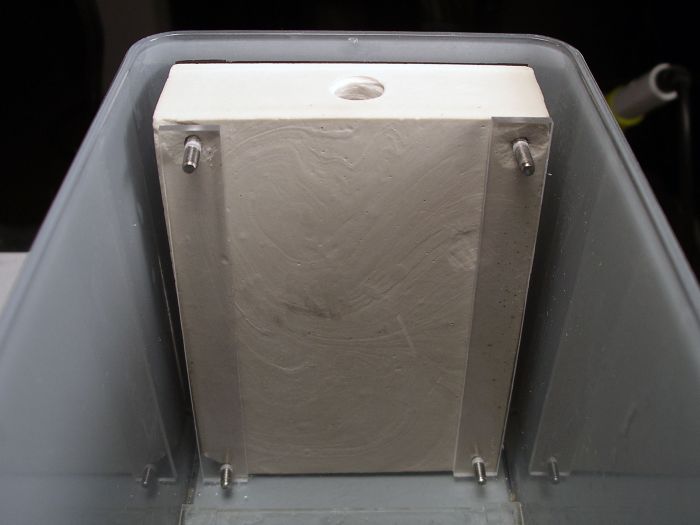
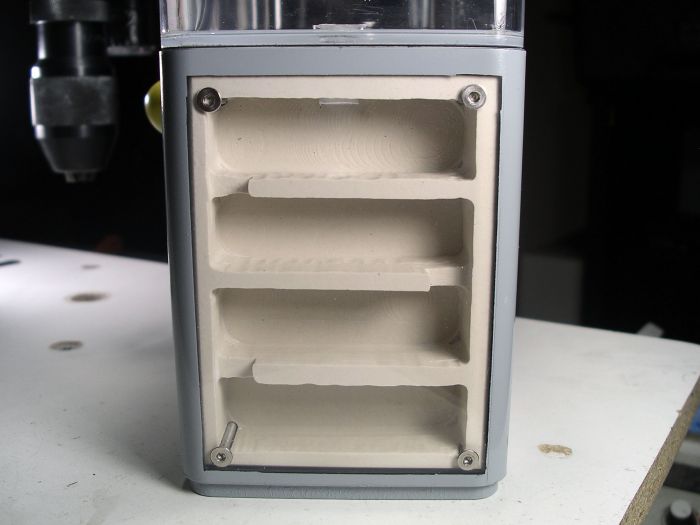
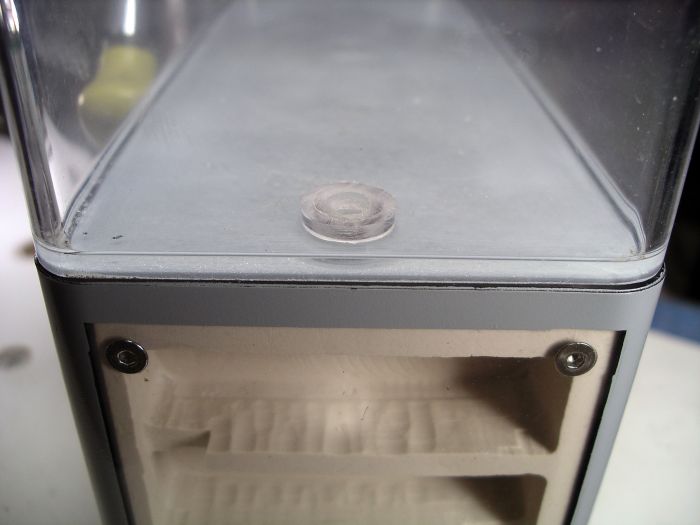
Not the greatest looking job, but it's just for testing.
I also solved the problem with the hot-melt glue giving way and the sponge falling off the water tank. Weld-on 16 (solvent acrylic mixture) seems to hold it on much better.
To give it a try, I carved a simple nest out of a Hydrostone block to use with the first prototype that I removed the chewed up Ytong nest from.




Not the greatest looking job, but it's just for testing.
I also solved the problem with the hot-melt glue giving way and the sponge falling off the water tank. Weld-on 16 (solvent acrylic mixture) seems to hold it on much better.
#120
 Offline
-
Posted January 15 2015 - 9:07 PM
Offline
-
Posted January 15 2015 - 9:07 PM
How did you fix the hydrostone erosion problem?
Also tagged with one or more of these keywords: formicarium, container, out world, enclosure, how-to, diy, design, dspdrew, nest, tutorial
 |
Off-Topic →
General Off-Topic →
3D printing Corner!Started by OwlThatLikesAnts , Nov 10 2025 |
|

|
|
Market Place →
General Market Place →
Possible THA Formicarium for sale in ArizonaStarted by sacs4010 , Aug 20 2025 |
|

|
||
Ant Keeping →
General Ant Keeping →
Leaving tomorrow, don't know what to do with Brachymyrmex depilisStarted by AntBooper600 , Jul 20 2025 |
|

|
||
Market Place →
General Market Place →
Temnothorax's Formicarium StopStarted by Temno , Jun 30 2025 |
|

|
||
Ant Keeping →
General Ant Keeping →
Best Nest Material for Myrmecia?Started by AntInSpaceFilms , Apr 6 2025 |
|

|
0 user(s) are reading this topic
0 members, 0 guests, 0 anonymous users

